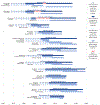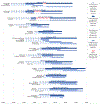Patents And Regulatory Exclusivities On Inhalers For Asthma And COPD, 1986-2020
- PMID: 35579925
- PMCID: PMC10328096
- DOI: 10.1377/hlthaff.2021.01874
Patents And Regulatory Exclusivities On Inhalers For Asthma And COPD, 1986-2020
Abstract
Inhalers are the mainstay of treatment for asthma and chronic obstructive pulmonary disease (COPD). These products face limited generic competition in the US and remain expensive. To better understand the strategies that brand-name inhaler manufacturers have employed to preserve their market dominance, we analyzed all patents and regulatory exclusivities granted to inhalers approved by the Food and Drug Administration between 1986 and 2020. Of the sixty-two inhalers approved, fifty-three were brand-name products, and these brand-name products had a median of sixteen years of protection from generic competition. Only one inhaler contained an ingredient with a new mechanism of action. More than half of all patents were on the inhaler devices, not the active ingredients or other aspects of these drug-device combinations. Manufacturers augmented periods of brand-name market exclusivity by moving active ingredients from one inhaler device into another ("device hops"). The median time from approval of an originator product to the last-to-expire patent or regulatory exclusivity of branded follow-ons was twenty-eight years (across device hops on fourteen originator products). Regulatory and patent reform is critical to ensure that the rewards bestowed on brand-name inhaler manufacturers better reflect the added clinical benefit of new products.
Figures



References
-
- Global Initiative for Asthma. Global Strategy for Asthma Management and Prevention (2021 Update) [Internet]. Fontana, WI; 2021. [cited 2022 Jan 29]. Available from: https://ginasthma.org/gina-reports/.
-
- Global Initiative for Chronic Obstructive Lung Disease. Global Strategy for the Diagnosis, Management, and Prevention of Chronic Obstructive Pulmonary Disease: 2021 Report [Internet]. 2020. [cited 2022 Jan 29]. Available from: https://goldcopd.org/wp-content/uploads/2020/11/GOLD-REPORT-2021-v1.1-25....
Publication types
MeSH terms
Substances
Grants and funding
LinkOut - more resources
Full Text Sources
Medical

